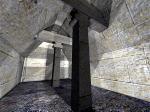Summary (English)
Following a report from the Guardia di Finanza (FG), excavations began where a piece of agricultural machinery had collapsed into a chamber tomb about 3.30 m below ground level. The exceptional tomb, on an east-west alignment, is of great historical and archaeological importance.
The excavations intercepted the dromos, through the original entrance and doorjambs. It was built with a series of squared tufa blocks laid one of top of the other, plastered and painted with vertical red bands, topped by an architrave and closed by a false dome formed by the progressive projection towards the interior of the rows of blocks. From the dromos, the funerary chamber was entered and here tufa blocks were found on which a male head shown in left-facing profile could just be seen below a wide band of red. The face and neck were an intense red colour; the eyes, eyebrows, and curly hair were black. It had slightly pointed ears, also red, and a white tunic covered part of the bust.The lower part of a human figure, probably part of the same figure as the male head, was sculpted on another block above a wide red band. The feet were visible, seen in left-facing profile with well-defined anatomical detail and were an intense red colour.
Numerous pottery fragments from the vessels making up the rich tomb group were recovered, belonging to various classes (Red-figure, banded ware, mixed style, cooking wares, red-painted and black glaze). Fragments from prestigious alabaster vases (_alabastra_, unguentaria, pyxes) were present, in addition to fragments from large plain ware containers for foodstuffs. Other objects included iron and bronze fibulae, rings, strigils, knives, lance and javelin points, together with objects pertaining to female cosmetics “_kommotike techne_”, in particular a bronze spatula.
The discovery of yellowish grooved blocks, made from a mixture of sand, tufa, and stone, and a number of large pieces of iron, suggests the presence of funerary beds (_klinai_).
The rectangular tomb is 4.902 m long, 2.558 m wide and a maximum height of 2.996 m. Made from tufa blocks bonded with mortar and lime, the lower part of the walls is perfectly vertical and it has a pitched vault roof, formed by rows of blocks terminating at the summit with a central beam of tufa blocks.
The chamber was divided into two aisles by a row of columns terminating with Ionic-Tuscan type capitals, in turn topped by an architrave that distributed and lightened the weight of the pitched vault and walls.
The columns were slightly flared towards the bottom and covered with a layer of whitish-yellow plaster made with alabaster gypsum, while the echinus on the capitals was decorated with stucco of which clear traces remained.
Traces of a painted, figured decoration were preserved on the walls: combat, duels, banquets, chariots with various personalities, in a vast range of colours.
Large iron nails, still in situ, were fixed into the back wall. These must have been used to hang up metal objects such as shields, strigils, belts, and bronze vessels.
The floor was made of large squared tufa blocks on a make up formed by a thick layer of compact sand.
The pottery finds and pictorial style suggest the tomb dates to within the second half of the 4th century B.C. Considering its monumental architecture, rather rare painted decoration and the precious artefacts associated with both male and female depositions, it seems likely that this was the tomb of an aristocratic couple.From a structural and architectural point of view, the tomb has parallels, in particular the pitched vault, with 4th century B.C. chamber tombs at Capua belonging to aristocratic Campanians. However, it differs from the latter in its monumentality, the presence of Ionic-Tuscan type capitals, as well as the central beam on the vault summit, which has Etruscan associations (Tarquinia, Cerveteri).
The painted figures recall Capuan examples. It is known that there was a relationship with the Campanian area, as ancient Tiati (Teano) was situated on the frontier between the Daunian and the Campano-Samnite territories.
- Giovanna Pacilio - Soprintendenza per i Beni Archeologici della Puglia
Director
Team
Research Body
- Soprintendenza per i Beni Archeologici della Puglia






![Download [PDF]](/excavation/skins/fasti/images/results/download_sml.png)
